Abstract
Background:
Solid waste management has emerged as an important human and environmental health issue. Municipal solid waste workers (MSWWs) are potentially exposed to a variety of occupational biohazards and safety risks. The aim of this study was to describe health practices and safety measures adopted by workers in the main municipal company in Alexandria (Egypt) as well as the pattern of the encountered work related ill health.
Methods:
A cross-sectional study was conducted between January and April 2013. We interviewed and evaluated 346 workers serving in about 15 different solid waste management activities regarding personal hygiene, the practice of security and health care measures and the impact of solid waste management.
Results:
Poor personal hygiene and self-care, inadequate protective and safety measures for potentially hazardous exposure were described. Impact of solid waste management on health of MSWWs entailed high prevalence of gastrointestinal, respiratory, skin and musculoskeletal morbidities. Occurrence of accidents and needle stick injuries amounted to 46.5% and 32.7% respectively. The risk of work related health disorders was notably higher among workers directly exposed to solid waste when compared by a group of low exposure potential particularly for diarrhea (odds ratio [OR] = 2.2, 95% confidence interval [CI] = 1.2-3.8), vomiting (OR = 2.7, 95% CI = 1.1-6.6), abdominal colic (OR = 1.9, 95% CI = 1.1-3.2), dysentery (OR = 3.6, 95% CI = 1.3-10), dyspepsia (OR = 1.8, 95% CI = 1.1-3), low back/sciatic pain (OR = 3.5, 95% CI = 1.8-7), tinnitus (OR = 6.2, 95% CI = 0.3-122) and needle stick injury (OR = 3.4, 95% CI = 2.1-5.5).
Conclusions:
Workers exposed to solid waste exhibit significant increase in risk of ill health. Physician role and health education could be the key to assure the MSWWs health safety.
Keywords: Hazards, ill-health, municipal solid waste workers, occupational, self-care
INTRODUCTION
Municipal solid waste workers (MSWWs) or refuse collectors, universally expose to many work related health hazards and safety risks, notably allergic and other diseases of the respiratory system. Health impacts could also entail musculoskeletal, gastro-intestinal and infectious diseases as well as injuries caused by work-related accidents.[1,2,3,4,5] Communal wastes comprise organic dust and bio-aerosol stuffed with micro-organisms (bacteria, viruses and fungi), endotoxins, and various toxic organic and inorganic chemicals that are aggravated in leachate resulting from a sanitary landfill.[6,7,8] However, control of these work conditions and enforcement of appropriate hygienic measures are difficult due to the lack of hygiene standards for biohazardous materials present in the air of the workplace.[4,9,10]
Workers can be protected by employing safety procedures in the workplace and ensuring the use of adequate personal protective equipment.[2]
Health impact and morbidity data about occupational exposure to solid waste among MSWWs is scarce. No studies have been conducted thus far in Egypt regarding exposure and health effects among workers engaged in solid waste collection, processing and disposal. According to the information available, this work provides a description of the health impact of communal solid waste management among hundreds of employees in the main municipality company in Alexandria-Egypt in order to estimate the potential excess in risks to which MSWWs can be exposed and adverse health outcomes and to consequently call for corrective measures, occupational safety and health hazard evaluation and monitoring program using health risk reduction behaviors models.
METHODS
Study setting and design
A cross-sectional study was conducted between January and April 2013, among MSWWs in the main municipality company in Alexandria (Egypt). This company was established in 2001 to deal with all types of solid waste [Figure 1] generated from different sources; residential, shops, industrial, agricultural, and hospitals medical waste in all municipal districts of Alexandria. Its total area is about 14 square kilometers comprising three waste storage station, three sorting and recycling plants, one factory for fertilizer production and one landfill site. The daily solid waste weight disposed at each discharge site is from 3 to 3.5 thousand tons. The company comprises a large laboring force of about 6000 permanent workers serving in several sectors concerned with waste collection, transportation, sorting, recycling, treatment, incineration, landfill and fertilizer production.
Figure 1.
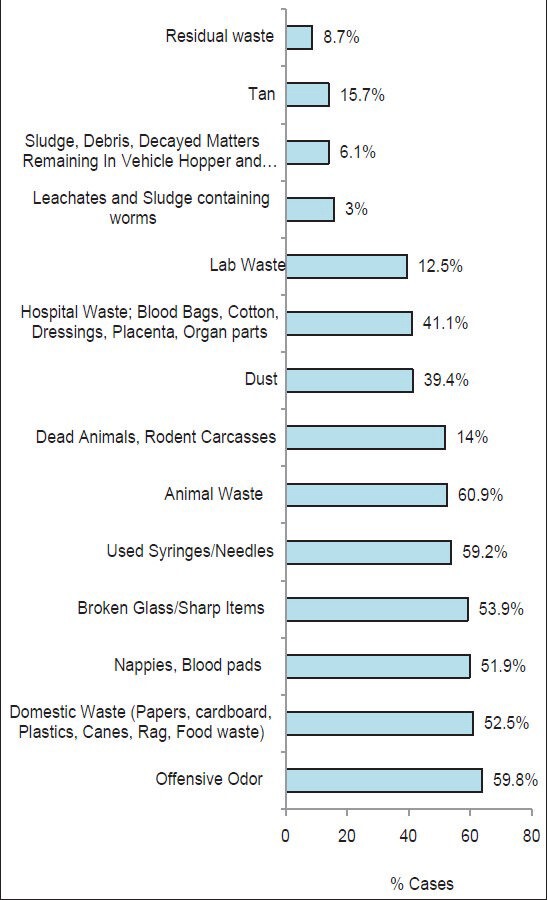
Health hazards encountered by MSWWs in the collection and sorting of waste and recyclables
Study population
The municipality was contacted and asked to participate in the study by a document describing the purpose and concerns of the study. The study comprised all current workers who were employed for 1 year or more by the municipality. A total of 1300 full-time employees were included in the study population. The consent was signed by 346 workers. We categorized the participants into two occupational groups (exposed; n = 186 and non-exposed; n = 160) on the basis of the direct exposure to solid waste. The exposure group included those working in the collection of mixed domestic and communal waste, street sweepers, workers engaged in loading, transfer and evacuation, sorting, incineration, dumping, landfilling, bin/scoop washing, and fertilizer production. Group 2 included transportation workers (vehicle/truck drivers), technical workers (mechanics, car and equipment maintenance, heavy equipment operators), welders, inspectors, timekeepers and other office workers who are supposed to be indirectly exposed.
Interviewing
Participants were interviewed (face to face) using a standardized pre-designed questionnaire form. The questionnaire was tested on a subset of 5 workers prior to starting to obtain information that might improve the work plan and facilitate the execution of the study. This pilot also enabled the adaptation of the questionnaire, the estimation of the time needed for interviewing the participants (20 min) and performing the physical examination. After necessary questionnaire modifications, the final data collection sheet was completed for each participant and covered general information about (age, gender, residence, education, marital status, socioeconomic level, work activity, duration of work, complete medical history and work related complaint, occurrence of risky occupational exposures and wearing of personal protective clothes: Disposable thick gloves, head covers, boots, masks goggle, or overalls). The questionnaire form included also questions about the practice of personal hygienic measures. All participants were subjected to complete physical examination.
Data analysis
Data were analysed using SPSS (Statistical Package for the Social Sciences) software Version16.0 (SPSS Inc., Chicago, IL, USA). Differences in proportions were evaluated by Pearson's Chi-square test; P < 0.05 was considered to be statistically significant. OR was used as a measure of the strength of association. Pearson's correlation coefficient was used to assess correlations between variables.
ETHICAL CONSIDERATIONS
The study was approved by the institutional review board of the High Institute of Public Health-Alexandria University. Permission to conduct the study was obtained from the director of the company. All the medical waste handlers were given verbal information about the study and were assured about the confidentiality, protection and anonymity of their data. Informed consent was obtained in writing from the individuals participating voluntarily. Individuals found with physical ill-health were referred to hospital's physicians for management.
RESULTS
Communal waste collection
Household and health care waste collection in Alexandria is performed in a traditional way, with most domestic, waste products generated at homes being mixed together without being sorted (as followed in most of modern countries where three separate bins are used to separate paper, plastic and cardboard from broken glass or food waste). The mixed domestic waste is stored in plastic bags, to be stored in special plastic bins or metal containers in the street and collected every day by waste collectors. Waste collection vehicle is a compactor truck with a closed container or scoop for storage of the waste. Health care waste is collected by other vehicles. Loading system comprises automatic fork that align carefully with sleeves of waste containers through a set of levers. The containers is lifted till it get to top, the contents are slipped upside down and is emptied into vehicle hopper. Bulky garbage is compacted hydraulically forward by moving walls that oscillate to push waste to the rear of the vehicle. The collection vehicle transport waste to be evacuated at the discharge site that receives wastes from all municipal districts, where it is reloaded into loaders, weighed and transported to plants for sorting and recycling. Medical waste is treated by incineration or autoclaving and segregation. Part of un-reusable waste is used for fertilizer production and the remaining is transported to the dumping site for final disposal in pre-designed landfill cells. A network of pipes and wells are present to collect methane gas to be then burnt.
Socio-demographic characteristics of MSWWs
The total number of MSWWs enrolled in the study comprised 346 subjects. Most of them 344 (99.4%) were males and only 2 (0.6%) females. Equal numbers were from urban and rural residence. The majority were married 316 (91.1%) and almost above 30 (82.4%). About one-fourth of the participants were illiterate, one half (55.4%) were beyond primary education, while only 25 (7.2%) had a university education. According to the modified social scoring of Fahmy and El-Sherbini,[11] comparable percentages had low (51.4%) and very low (41%) socio-economic level. The sample was categorized into 15 occupational groups serving different tasks. The socio-demographic characteristics of the group directly exposed to solid waste differed significantly from that of the indirectly exposed group [Table 1]. Younger ages, rural residence, lower educational level, low socio-economic standard and being unmarried (single or divorced) were more encountered among the exposed group.
Table 1.
Sociodemographic characteristics of enrolled MSWWs
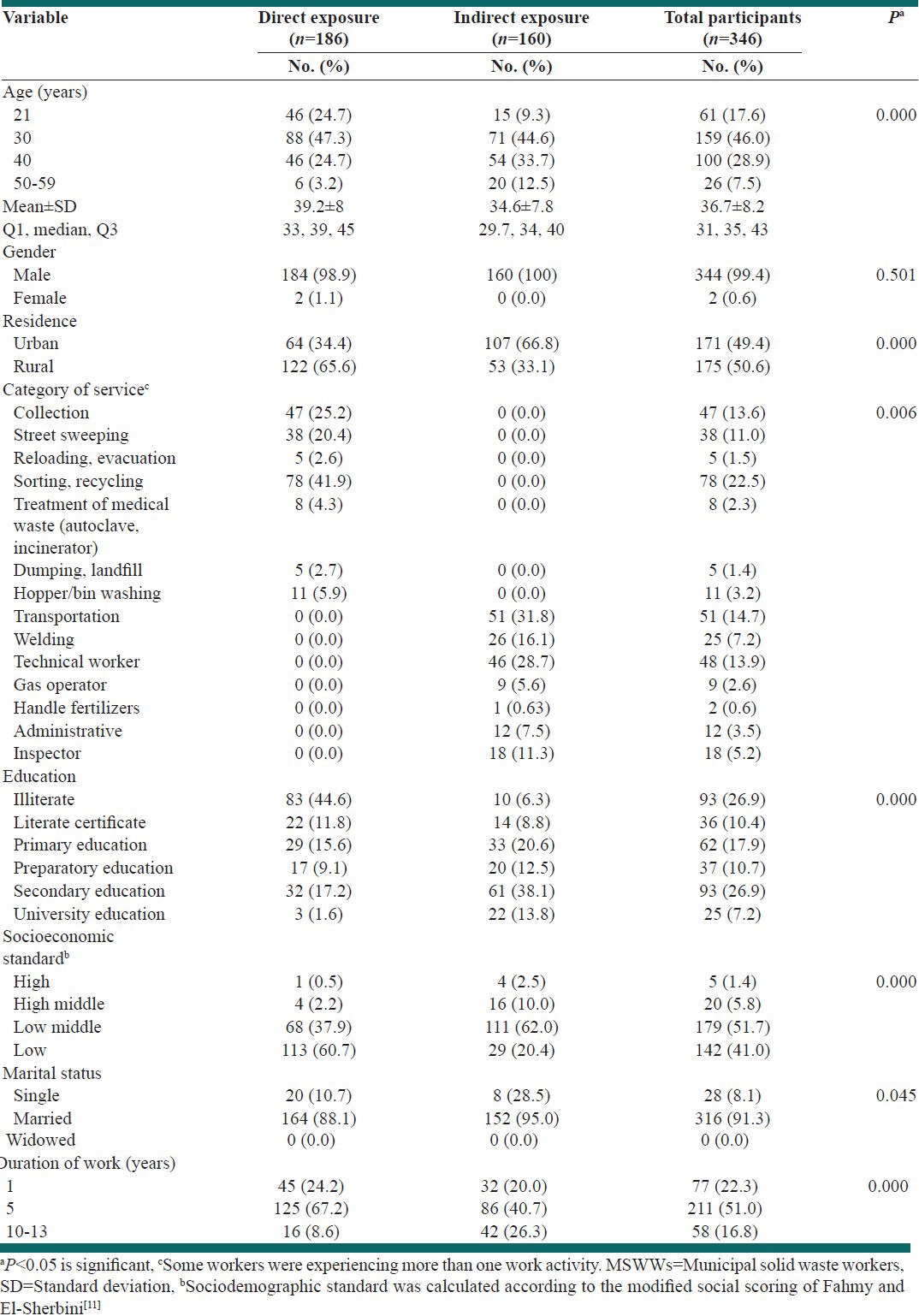
Health and safety practices for MSWWs
About two-thirds of the workers (60.7%) were using tools during work. The waste collectors and street cleaners used to use dust-pans (32.4%), sweepers (30.6%) and sometimes tweezers or tongs (8.4%). The use of hand brush and rigid receptacles for picking up sharp objects was infrequent and reported by only 16 (4.6%). About 1.7% were using floor cloth and a wiper for cleaning building floors and bathrooms. Five street sweepers (1.4%) claimed that when the dust-pans are not provided they make use of two woody plates that they adapt for collecting swept garbage. Workers in sorting and recycling plants were using a hock (15.3%) at one hand to catch and open plastic bags containing waste as they run along a conveyer belt where manual sorting starts. Nevertheless, a considerable number of the MSWWs were handling waste by their hands (with or without gloves) [Figure 2].
Figure 2.
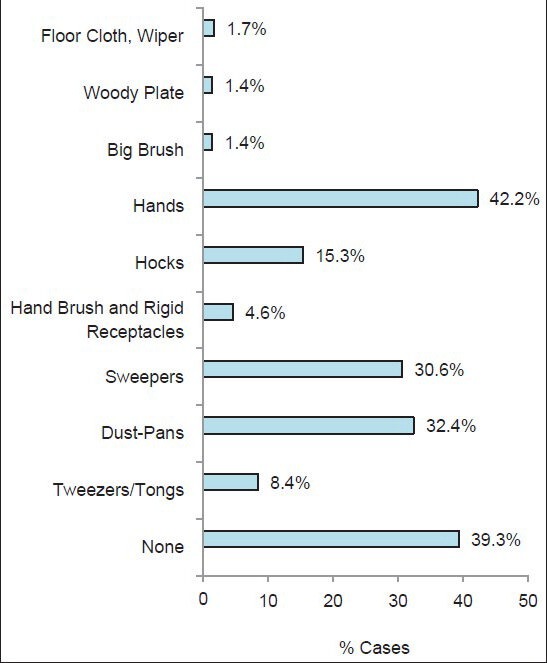
Tools used by municipal solid waste workers during work
About 75 (21.7%) workers were not wearing the recommended personal protective clothing [Figure 3]. This should include 36 (10.4%) personnel (inspectors and office workers) not exposing to waste. Safety boot and long sleeve gown (overall) were the most frequent protective clothing often used by almost two thirds of workers (61.6% and 66.2% respectively). Thick (heavy duty) gloves were used by only 29.8% of the workers; mainly sorters (38.4%), collectors (14.1%), welders (14.1%), sweepers (8.1%) and those handling medical waste. Head cover in the form of protective helmet or the ordinary cap was used by 30.3% of the workers. Eye protection was assured by safety goggles for 9.5% of MSWWs engaged in welding (50%), technical work (18.7%) or dumping (9.4%). Likewise, face mask was provided for 12.4% and was mainly used by sorters (39.5%), collectors (14%), technical workers (18.7%), those involved in medical waste autoclaving and incineration tasks (7%), landfilling (4.7%) and by inspectors (4.7%).
Figure 3.
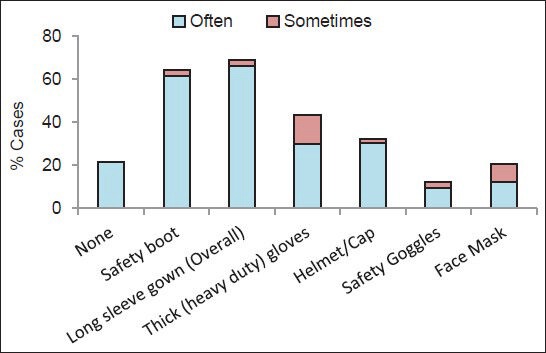
Available personal protective equipment used by municipal solid waste workers
Basic personal hygiene is essential for reducing the risks of ill health from handling waste. The majority of workers used to often wash their hands before eating (85.8%), if their hands become contaminated (77.5%) and before taking medications (56.1%). Hand washing was also often emphasized by MSWWs before using the toilets (43.4%), drinking (35.3%), wearing gloves (16.8%; 47.2% of those using gloves), using the cell phone (5.2%) and smoking (3.5%; 8.1% of smokers) [Figure 4].
Figure 4.
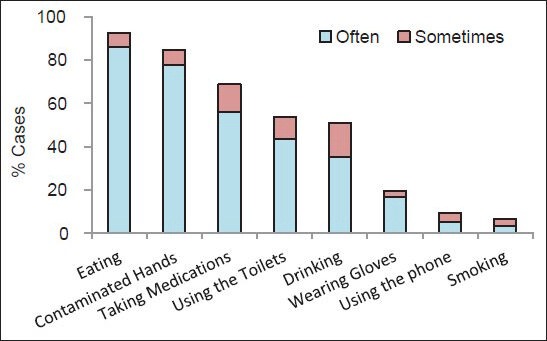
Frequency of hand washing practices among municipal solid waste workers
RISKY EXPOSURE AMONG MSWWS
Analysis of health hazards that may be encountered in waste management revealed that MSWWs are exposed daily to domestic waste including papers, cardboard, plastics, canes, rage, food waste (60.9%), feces in nappies or incontinence pads and blood in sanitary pads used by women during menses (59.8%), animal and domestic pets excreta, waste produced from pens or hutches, poultry and fish shops (52.5%), dead animals and rodent carcasses (51.9%, 6 workers stated that they sometimes find dead human bodies, particularly newborns in the waste stream), pins and used syringe/needles (53.9%; 32.7% reported needle stick injury), broken glass and other sharp items (59.2%), laboratory waste (39.4%), hospital waste including papers, cardboard, plastics, canes, rage, food waste (41.4%), dust (41.3%) and repugnant odor (63.8%), sludge, debris, decayed matters remaining in vehicle hopper and containers (14%), leachates and sludge that sometimes contains worms (15%) and tan (13.8%).
ADVERSE HEALTH PROBLEMS
We compared prevalence of health disorders between MSWWs in two groups according to the direct exposure to solid waste; exposed and non-exposed. The risk was notably higher among the exposed workers [Table 2]. The most frequent complains encountered among MSWWs were cough (29.1%), fatigue (27.5%), headache (21.1%) and a number of constitutional symptoms notably fever, malaise, night sweating, anorexia and dizziness that were experienced by (9.5%, 8.9%, 3.5% and 6.9% and 0.6% respectively). These probably constitute symptoms of organic dust toxic syndrome.[5]
Table 2.
Prevalence and OR for self-reported health outcomes among enrolled MSWWs
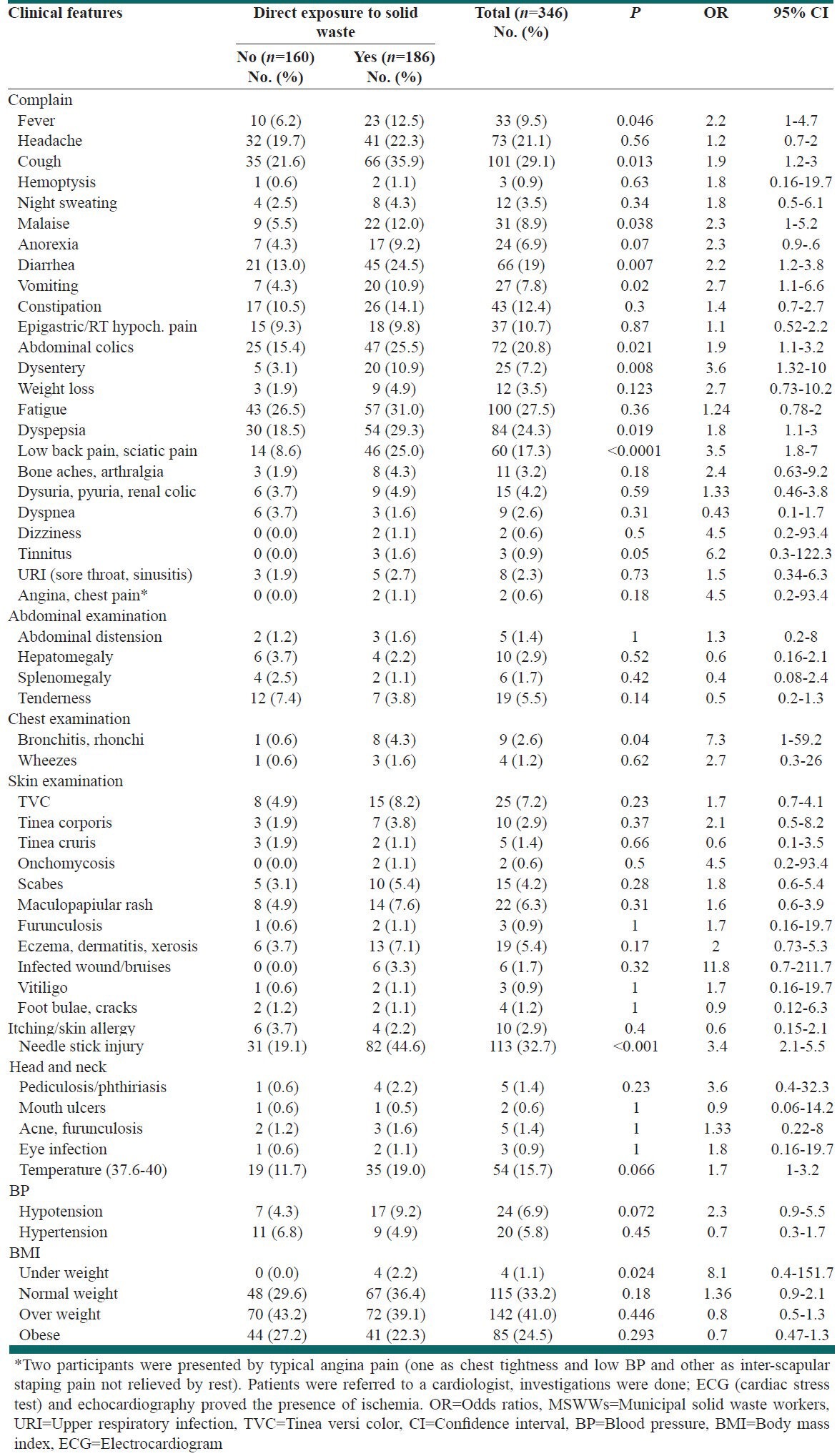
Gastrointestinal (GIT) complaints were significantly higher among the exposed group. Frequent attacks of abdominal colics, diarrhea, dyspepsia, vomiting, or dysentery were reported by (25.5%, 24.5%, 24.3%, 10.9% and 10.9% respectively).
Muscloskeletal complains were not uncommon. Low back pain and sciatic pain constituted 17.3% (one case had definitive lumbar disc prolapse), whereas generalized bone aches and arthralgia affecting mainly knee, hip, shoulder and neck joints were reported by 3.2%.
Other complains included upper respiratory infection (sore throat, sinusitis) (2.3%), dysuria, pyuria, renal colic (4.2%), dyspnea (2.6%), hemoptysis (0.9%) and weight loss (3.5%).
Tinnitus was a complaint of 3 workers (0.9%) in sorting and recycling plant who expose to excessive noise. Two office employees complained of angina and chest tightness and cardiac catheterization revealed coronary obstruction. Hypotension was more prevalent among the exposed group (OR = 2.3, 95% CI = 0.9-5.5) who are supposed to exert more physical activity and lose water and salt in sweating, unlike the non-exposed group performing sedentary work more that showed a higher risk of hypertension. Likewise, weight loss (OR = 2.7, 95% CI = 0.73-10.2) and low BMI (OR = 8.1, 95% CI = 0.4-151.7) were evident among the exposed group whereas over weight and obesity were more prevalent among the other group.
Head and neck examination revealed that 1.2% of MSWWs have acne and scalp furunculosis, 0.9% have eye infection; most probably conjunctivitis and 0.6% have mouth ulcers. Pediculosis and phthiriasis were detected in scalp and eye lashes of 1.4%.
Abdominal distention (1.4%), hepatomegaly (2.9%), splenomegaly (1.7%) and abdominal tenderness (5.5%) were evident in abdominal examination, whereas chest auscultation revealed rhonchi and wheezes in 1.2% of the evaluated participants.
On skin examination, fungal infections were frequent (tinea versi color [7.2%], tinea corporis [2.6%], tinea cruris and [1.7%] and onchomycosis [0.6%]). Scabes, maculopapular rash, eczema/dermatitis, furunculosis (boils), infected wound, foot bullae/cracks and vitiligo, were seen in (4.2%, 6.3%, 5.4%, 0.9%, 1.7%, 1.2% and 0.9% respectively). About 3% of the MSWWs were complaining of pruritus due to skin allergy.
History of work related accident or trauma namely contusions, lacerations, sprains, fracture, or bites was reported by 46.5% of the workers whereas needle stick injury constituted 32.7%.
Distribution of health disorder by category of work service is detailed in [Table 1]. Symptoms in general were more prevalent among sorting workers and collectors.
DISCUSSION
Municipal waste management is a livelihood to poor people of low educational levels, inadequate housing conditions in rural residence, large family size with insufficient family income. In Egypt, this job is mainly and formally performed by male employees and the same applies in other countries.[12,13,14] These coincide with the current results. Workers involved in waste collection, sorting, treatment and landfill and thus directly exposed to solid waste had lower socio-economic standard, lower educational level and resided rural areas where life conditions lags behind urban communities. Being single or divorced also reflects poor life conditions and inability to afford marriage expenses. The workers indirectly exposed to solid waste were involved more in technical work that necessitates certain degree of specialized knowledge and thus higher levels of education and socioeconomic life.
MSWWs are exposed to more occupational health and safety risks than workers in many other industries.[15] In this study, we show that MSWWs performing different tasks in waste management differ in risk of acquiring adverse health effects. Participants from 15 work services were evaluated and statistically categorized into two groups (directly and indirectly exposed groups or potential high and low exposure groups). Those not directly engaged in the waste handling such as truck drivers claimed that they used to help collectors and reloading workers during truck loading and evacuation. Moreover, mechanics, welders and technicians stated that they can repair broken vehicle or rolling conveyer while being loaded with waste. These workers do not often put their personal protective clothes and hence tend to handle waste with bared hands and without making use of any tool.
Although strongly recommended, personal protective equipment was not regularly used by a considerable number of the participants. Some reasoned that for the shortage in its supply that they can receive pair of thick heavy duty gloves every 3 month, if they are torn during work, not replaced. Hence they put only one pair or use the torn one for minimal protection. This holds true for safety boots and gowns supplied every 1 year. Others (especially technical worker and truck drivers) claimed that they prefer working without wearing gloves as they limit their free movement during work or cause skin irritation and dryness.
Most of the participants were aware of the importance and timing of hand washing and hygienic practices. Nevertheless, no convenient washing facilities (with warm water and soap) were available near the collection points, work station in landfill site, or for those working in the street. Moreover, lay people of low socio-economic standard do not always practice hand or mouth washing.
This is the first comprehensive study in Egypt that reviewed the health problems encountered among the MSWWs that entailed GIT, respiratory, muscloskeletal, cutaneous and constitutional symptoms as well as allergies and accidents.
GIT symptoms such as diarrhea, dysentery, vomiting and nausea are well-known problems among sewage,[16] waste water treatment[17] and MSWWs[18] workers exposed to high concentrations of airborne gram negative bacteria[18] since waste handling may cause dust full of microorganisms and bacterial endotoxins to become aerosolized. Moreover, direct skin contact of these waste matter stuffed with fungal spores, bacteria, viruses and parasitic ova that can cause diarrhea via feco-oral route.[5,10] In agreement with reports from Poulsen et al., and 1995, Hours et al., 2003,[5,19] the exposed group were at higher risk of diarrheal disease compared with the non-exposed group. On the other hand, Nielsen et al. did not find any excess of GIT symptoms among the household waste collectors possibly due to lower concentration of bacteria they estimated in the waste.[20]
Helicobacter pylori was incriminated as a causative agent of dyspepsia and epigastric pain among waste water treatment and sewage workers[21,22] and hence we can hypothesis that the high prevalence of dyspepsia among MSWWS especially sorting workers and collators in the present study is due to H. pylori infection. Some of the participants indicated factors in their work environment, generally the repugnant odor of rotten waste that they inhale are the causes of hurt burn and GIT perturbations.
Palpable liver and spleen found on examination in 2.9% and 1.7% respectively of participants and significantly higher in the non-exposed group are not related waste exposure rather than consequences of bilharzias. This disease is endemic in Egypt and was proved to infect 13.3% of studied participants where Schistosoma mansoni egg was detected in their stool (Eassa et al., manuscript in preparation).
Several studies have pointed to the possible effects of waste on respiratory function and correlated that to the high dust levels, micro-organisms, fungal spores and endotoxins[2,3,18,20,23] or the presence of higher levels of total suspended particulate matter than the local standards that can impair lung function on chronic exposure.[24]
Higher prevalence of respiratory complains particularly cough (dry or productive) were found amongst collectors, sorting workers, street cleaners, truck drivers, landfill workers, welders, and vehicle technicians who are subjected to variable direct exposure to both chemical and biological sensitizers in the workplace. More specifically, collectors who ride on footplates on the backs of the trucks and truck drivers are exposed to exhaust fumes, cleaners are exposed to street dust, sorters are exposed to molds and bioaerosole,[7] welders are exposed to reactive oxygen species, carbon mono-oxide and welding fumes containing heavy metals,[25,26] mechanics are exposed to benzene and paints, and workers in dumping sites are exposed to bioaerosole, dust and harmful methane gas.[27] Some workers experienced breathlessness probably due to air way obstruction and inflammation as stated earlier.[28,29]
This study provided some insight into work related dermatoses that were common among MSWWs. No significant difference was observed between both evaluated groups albeit with higher rate among the exposed group. Fungal infection especially tinea versicolour and tinea corporis were the commonest. This was seldom described in the literature where observed skin diseases pointed to callused palms, bruises, dermatitis, folliculitis, abrasions, and xerosis.[5,30,31] Previous studies has assessed fungal air contamination in waste stations and confirmed the presence of three fungal species: Aspergillus flavus, Aspergillus fumigatus, and Stachybotrys chartarum which cause pulmonary disease.[7,32] Since tineas are known to be caused by dermatophytes, further studies are needed to investigate their contamination to work environment.
Given their exposure to other air-borne contaminants, it was reasonable to find scabetic workers. These workers wear their gowns potentially contaminated with Srcoptes scabii for months. Moreover, poor and illiterate people engaged in such work do not wash frequently. This also explains the presence of other ectoparasitc infestations such as pediculosis and phthiriasis.
Pruritus due to skin allergies were more prevalent among the non-exposed groups especially the technical workers that included mechanics, vehicle and equipment maintenance workers, heavy equipment operators who directly expose to skin irritants and used to work without the use of protective gloves. This category experienced 8.4 increased risk of work related accidents as compared to the exposed group (P = 0.004) due to manipulation of heavy and moving objects, repeated pressure, pounding, friction and vibration.
Dermal injuries comprised needle stick injuries caused by disposable needles originating from residential and health care sources and accounted for 32.7% of the claims. Cut wounds that were also found infected in six workers were reported to be caused by sharp objects bumped into skin, disposable razors, broken glass, pins, sharp can lids, thorns, or broken tree limbs. Workers described loose needles and such materials as commonly protruding from uncontained disposal or ruptured garbage bags in the waste stream and puncture skin, when handled by collectors or during manual sorting in recycling plants.
Waste collection is also a task which requires repeated heavy physical activity such as heavy lifting, carrying, pulling/pushing of bins and containers that involve static muscle contraction and hence increases the risk of musculoskeletal problems.[2,12,33] Abou-Elwafa et al. showed in a recent study conducted in Egypt higher percentage of musculoskeletal complaints (60.8%) among MSWWs particularly waste collectors where low back pain was the most frequently reported (22.5%).[12] We report high prevalence (17.3%) of low back pain and sometimes sciatica among MSWWs that was significantly higher among the exposed group (OR = 3.5, 95% CI = 1.8-7). Collectors were the most frequently affected (33.3%). This could be attributed to the large volume of refuse they have to pack manually and hold above shoulder level or due to un-acquaintance with the proper safety maneuver that should be adopted while being in duty. Moreover, in Egypt workers tend to use old and traditional equipment and depend mainly on the physical power. The existence of low back pain, bone aches and arthralgia did not significantly correlate with the duration of work (r = 0.041, P = 0.44) suggesting that musculoskeletal disorders are related to exerting improper physical maneuver rather than the frequency of sustained muscle action. Moreover, workers get their positions upgraded (crew chef, inspectors) after spending certain number of years in employment.
LIMITATIONS OF THE STUDY
The present work is limited by the use of cross-sectional design, the lack of specific exposure assessment and a standard threshold level for exposure and the healthy worker effect. Further research implementing case control approach is needed to calculate attributable risk.
CONCLUSIONS AND RECOMMENDATIONS
The high prevalence of accidents and skin injuries revealed in the present study calls for new standardized guidelines and measures to improve work safety in hazardous waste collection, transport and handling. Protection against personal injury is essential for all workers. All risks should be identified and suitable protection from those risks should be provided. Most participants especially those directly involved in waste handling reported receiving job safety and hygiene training. However, this compulsory pre-employment training should be expanded to cover measures to be taken if exposed to biohazards and unexpected medical waste.
Although medical waste is collected and disposed in different settings, observation of medical waste (disposable needles, syringes, blades, IV lines, bandages and blood bags) in the general waste stream was common. This indicates the need for proper handling, containment or destruction of these dangerous materials by users prior to disposal. Campaign must be organized to educate citizens about the importance of sorting waste before disposal.
Action must focus on improving and intensifying preventive measures to minimize bioaerosol levels at work stations by installing vacuum cleaning system and enclosing conveyers. Wearing of internationally recommended personal protective dressing[34] should be enforced, making the protection of skin, eyes, eyes and respiratory airway more effective. Special filters should be provided for welding, cleaners and landfill personnel as respiratory protective devices that will significantly reduce the risk of ill health.
The transfer of two-wheeled container to be hydraulically lifted and emptied by the truck should be carried out by two to three persons instead of one. The hopper should not be over loaded by waste to ovoid over spill that is then gathered by bared hands of drivers and transfer workers.
Effective personal hygiene must be maintained by provision of adequate including mild soap, towels or even cleansing wipes on collection vehicles and effective skincare regime using mild cleansers and pre-work and after-work barrier skin creams to keep the skin moisturized.
Physician should intensify medical supervision and organize health education sessions for diffusing clear job guidelines concerning number of working hours and maximum weight limits for packing, carrying or pulling to avoid muscle and joint strains. They should also consult MSWWS about how to avoid musculoskeletal disorders and educate the correct physical movement while pulling, carrying or pushing heavy objects, also the early signs of joint affection.
Future research should elaborate more on these emerging issues and seek the construction of a health risk reduction behaviors models to help protect the health of MSWWs and drive authorities to adopt safer management techniques.
ACKNOWLEDGMENTS
The authors would like to thank all participants enrolled in the study, the director and the manager of the medical sector of the company for their kind cooperation.
Footnotes
Source of Support: Nil
Conflict of Interest: None declared.
REFERENCES
- 1.Rushton L. Health hazards and waste management. Br Med Bull. 2003;68:183–97. doi: 10.1093/bmb/ldg034. [DOI] [PubMed] [Google Scholar]
- 2.Dorevitch S, Marder D. Occupational hazards of municipal solid waste workers. Occup Med. 2001;16:125–33. [PubMed] [Google Scholar]
- 3.Abdou MH. Health impacts on workers in landfill in Jeddah City, Saudi Arabia. J Egypt Public Health Assoc. 2007;82:319–29. [PubMed] [Google Scholar]
- 4.Kuijer PP, Sluiter JK, Frings-Dresen MH. Health and safety in waste collection: Towards evidence-based worker health surveillance. Am J Ind Med. 2010;53:1040–64. doi: 10.1002/ajim.20870. [DOI] [PubMed] [Google Scholar]
- 5.Poulsen OM, Breum NO, Ebbehøj N, Hansen AM, Ivens UI, van Lelieveld D, et al. Collection of domestic waste. Review of occupational health problems and their possible causes. Sci Total Environ. 1995;170:1–19. doi: 10.1016/0048-9697(95)04524-5. [DOI] [PubMed] [Google Scholar]
- 6.Krajewski JA, Tarkowski S, Cyprowski M, Buczyńska A. Characteristics of jobs and workers employed in municipal waste collection and disposal by the city of Lodz. Med Pr. 2000;51:615–24. [PubMed] [Google Scholar]
- 7.Malta-Vacas J, Viegas S, Sabino R, Viegas C. Fungal and microbial volatile organic compounds exposure assessment in a waste sorting plant. J Toxicol Environ Health A. 2012;75:1410–7. doi: 10.1080/15287394.2012.721175. [DOI] [PubMed] [Google Scholar]
- 8.Borrello P, Gucci PM, Musmeci L, Pirrera A. The microbiological characterization of the bioaerosol and leachate from an urban solid refuse dump: Preliminary data. Ann Ist Super Sanita. 1999;35:467–71. [PubMed] [Google Scholar]
- 9.Salkin IF. Geneva: World Health Organization, Department of Blood Safety and Clinical Technology and Department of Protection of the Human Environment World Health Organization; 2004. Review of Health Impacts from Microbiological Hazards in Health-Care Wastes. [Google Scholar]
- 10.Krajewski JA, Tarkowski S, Cyprowski M. Hazardous health effects in communal waste collection and disposal workers. Med Pr. 2000;51:159–72. [PubMed] [Google Scholar]
- 11.Fahmy S, El-Sherbini A. Simple parameters for social classifications for health research. Bull High Inst Public Health. 1983;13:95–107. [Google Scholar]
- 12.Abou-Elwafa HS, El-Bestar SF, El-Gilany AH, Awad Eel-S. Musculoskeletal disorders among municipal solid waste collectors in Mansoura, Egypt: A cross-sectional study. BMJ Open. 2012;2 doi: 10.1136/bmjopen-2012-001338. pii:e001338. [DOI] [PMC free article] [PubMed] [Google Scholar]
- 13.Kuijer PP, Frings-Dresen MH. World at work: Refuse collectors. Occup Environ Med. 2004;61:282–6. doi: 10.1136/oem.2002.001172. [DOI] [PMC free article] [PubMed] [Google Scholar]
- 14.Inyang M, editor. Ljubljana, Slovenia: International Conference “Waste Management, Environmental Geotechnology and Global Sustainable Development (Icwmeggsd’07-Gzo’07)”; 2007. Aug 28-30, Health and safety risks amongst the municipal solid waste collectors in Port Harcourt Metropolis of the Niger Delta Region of Nigeria. [Google Scholar]
- 15.Huren A. Occupational health and safety amongst municipal solid waste workers in Florida. Waste Manage Res. 1999;17:369–77. [Google Scholar]
- 16.Lundholm M, Rylander R. Work related symptoms among sewage workers. Br J Ind Med. 1983;40:325–9. doi: 10.1136/oem.40.3.325. [DOI] [PMC free article] [PubMed] [Google Scholar]
- 17.Khuder SA, Arthur T, Bisesi MS, Schaub EA. Prevalence of infectious diseases and associated symptoms in wastewater treatment workers. Am J Ind Med. 1998;33:571–7. doi: 10.1002/(sici)1097-0274(199806)33:6<571::aid-ajim8>3.0.co;2-t. [DOI] [PubMed] [Google Scholar]
- 18.Ivens UI, Ebbehøj N, Poulsen OM, Skov T. Season, equipment, and job function related to gastrointestinal problems in waste collectors. Occup Environ Med. 1997;54:861–7. doi: 10.1136/oem.54.12.861. [DOI] [PMC free article] [PubMed] [Google Scholar]
- 19.Hours M, Anzivino-Viricel L, Maitre A, Perdrix A, Perrodin Y, Charbotel B, et al. Morbidity among municipal waste incinerator workers: A cross-sectional study. Int Arch Occup Environ Health. 2003;76:467–72. doi: 10.1007/s00420-003-0430-0. [DOI] [PubMed] [Google Scholar]
- 20.Nielsen EM, Breum NO, Herbert Nielsen B, Wurtz H, Poulsen OM, Midtgaard U. Bioaerosol exposure in waste collection: A comparative study on the significance of collection equipment, type of waste and seasonal variation. Ann Occup Hyg. 1997;41:325–44. [Google Scholar]
- 21.Friis L, Engstrand L, Edling C. Prevalence of Helicobacter pylori infection among sewage workers. Scand J Work Environ Health. 1996;22:364–8. doi: 10.5271/sjweh.155. [DOI] [PubMed] [Google Scholar]
- 22.Van Hooste W, Charlier AM, Rotsaert P, Bulterys S, Moens G, van Sprundel M, et al. Work-related Helicobacter pylori infection among sewage workers in municipal wastewater treatment plants in Belgium. Occup Environ Med. 2010;67:91–7. doi: 10.1136/oem.2008.040436. [DOI] [PubMed] [Google Scholar]
- 23.Athanasiou M, Makrynos G, Dounias G. Respiratory health of municipal solid waste workers. Occup Med (Lond) 2010;60:618–23. doi: 10.1093/occmed/kqq127. [DOI] [PubMed] [Google Scholar]
- 24.Chestnut LG, Schwartz J, Savitz DA, Burchfiel CM. Pulmonary function and ambient particulate matter: Epidemiological evidence from NHANES I. Arch Environ Health. 1991;46:135–44. doi: 10.1080/00039896.1991.9937440. [DOI] [PubMed] [Google Scholar]
- 25.Chen HL, Chung SH, Jhuo ML. Efficiency of different respiratory protective devices for removal of particulate and gaseous reactive oxygen species from welding fumes. Arch Environ Occup Health. 2013;68:101–6. doi: 10.1080/19338244.2011.650799. [DOI] [PubMed] [Google Scholar]
- 26.Yu KM, Topham N, Wang J, Kalivoda M, Tseng Y, Wu CY, et al. Decreasing biotoxicity of fume particles produced in welding process. J Hazard Mater. 2011;185:1587–91. doi: 10.1016/j.jhazmat.2010.09.083. [DOI] [PubMed] [Google Scholar]
- 27.Shi TM, Weng SF, Liu YW, Tao H, Wang X, Guo YF, et al. The analysis of adverse health effects of occupational hazards factors in one solid waste landfill. Zhonghua Lao Dong Wei Sheng Zhi Ye Bing Za Zhi. 2011;29:514–8. [PubMed] [Google Scholar]
- 28.Bresnitz EA, Roseman J, Becker D, Gracely E. Morbidity among municipal waste incinerator workers. Am J Ind Med. 1992;22:363–78. doi: 10.1002/ajim.4700220309. [DOI] [PubMed] [Google Scholar]
- 29.Thorn J, Rylander R. Inflammatory response after inhalation of bacterial endotoxin assessed by the induced sputum technique. Thorax. 1998;53:1047–52. doi: 10.1136/thx.53.12.1047. [DOI] [PMC free article] [PubMed] [Google Scholar]
- 30.Gellin GA. Dermatoses acquired by solid-waste handlers. Am J Ind Med. 1985;8:363–70. doi: 10.1002/ajim.4700080416. [DOI] [PubMed] [Google Scholar]
- 31.Ray MR, Roychoudhury S, Mukherjee G, Roy S, Lahiri T. Respiratory and general health impairments of workers employed in a municipal solid waste disposal at an open landfill site in Delhi. Int J Hyg Environ Health. 2005;208:255–62. doi: 10.1016/j.ijheh.2005.02.001. [DOI] [PubMed] [Google Scholar]
- 32.Kozajda A, Sowiak M, Piotrowska M, Szadkowska-Stańczyk I. Waste sorting plants – Recognition of exposure to biological agents (moulds) Med Pr. 2009;60:483–90. [PubMed] [Google Scholar]
- 33.Yang CY, Chang WT, Chuang HY, Tsai SS, Wu TN, Sung FC. Adverse health effects among household waste collectors in Taiwan. Environ Res. 2001;85:195–9. doi: 10.1006/enrs.2000.4235. [DOI] [PubMed] [Google Scholar]
- 34.Bangkok: Ministry of Health; 1995. Ministry of Health. Handbook of Hazardous Healthcare Waste Management in 10-Bed and 30-Bed Community Hospitals, Thailand. [Google Scholar]


